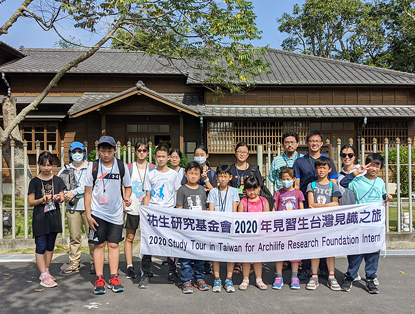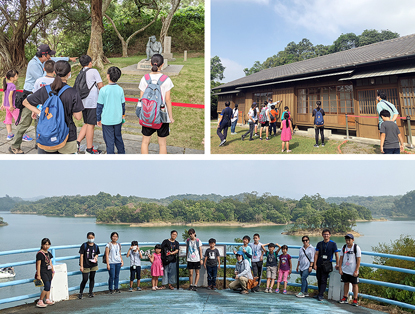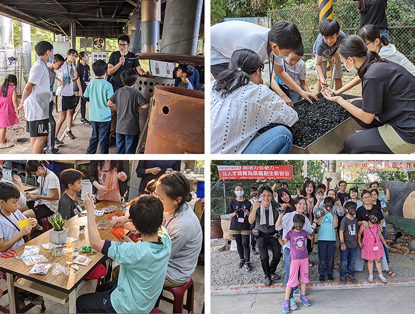Sketch of Archilife Study Tour, November 2020
|
2020年11月份見識之旅縮影  11月份見識之旅活動,於2020年11月22日由呂明澐小姐帶領15位祐生見習生及家長們,進行烏山頭水庫風光暨官田菱炭點石成金之旅。活動開始之初,領隊呂明澐小姐提醒本次活動注意事項及觀察重點,先行建立見習生的背景知識。 11月份見識之旅活動,於2020年11月22日由呂明澐小姐帶領15位祐生見習生及家長們,進行烏山頭水庫風光暨官田菱炭點石成金之旅。活動開始之初,領隊呂明澐小姐提醒本次活動注意事項及觀察重點,先行建立見習生的背景知識。For the study tour of November 22, 2020, Ms. Lu Ming-yun led 15 ARF interns and their parents on a tour of Wushantou Reservoir and learned about water caltrop biochar in Guantian District. At the start of the day's activities, team leader Ms. Lu Ming-yun reminded everyone about things to note and what to observe, and gave the interns some background knowledge.  本次上午行程以參訪烏山頭水庫為主軸,導覽人員首先帶領眾人來到八田與一紀念園區,園區位於烏山頭水庫北側,為紀念嘉南大圳的建造者-八田與一先生所建立,原址於日據時期有68棟建物,但幾乎全部毀損,遂原地打造紀念園區。導覽人員首先針對八田與一生平事蹟及其對台灣的水力貢獻進行解說,沿著行進方向逐一講述眼前的景物及日式建物,最後引領眾人參觀八田與一住宅,並在宅前的八田與一夫人銅像前聆聽兩位的愛情故事,讓眾人皆留下深刻印象。隨後前往遊艇搭乘處,坐在太陽能艇上緩緩離岸駛向水庫中央,觀賞其中的湖光山色,聽著導覽人員介紹水庫設施與八田先生建造水庫時的趣聞,讓人更加了解水庫的故事。中午用餐前,導覽人員帶領眾人來到餐廳旁的八田技師銅像前,說明該銅像製做原由,時至今日,嘉南大圳附近許多的農民都將八田先生當成嘉南地區水利及土地的保護神,不時前來膜拜,顯示出台灣人感恩圖報的美德。 本次上午行程以參訪烏山頭水庫為主軸,導覽人員首先帶領眾人來到八田與一紀念園區,園區位於烏山頭水庫北側,為紀念嘉南大圳的建造者-八田與一先生所建立,原址於日據時期有68棟建物,但幾乎全部毀損,遂原地打造紀念園區。導覽人員首先針對八田與一生平事蹟及其對台灣的水力貢獻進行解說,沿著行進方向逐一講述眼前的景物及日式建物,最後引領眾人參觀八田與一住宅,並在宅前的八田與一夫人銅像前聆聽兩位的愛情故事,讓眾人皆留下深刻印象。隨後前往遊艇搭乘處,坐在太陽能艇上緩緩離岸駛向水庫中央,觀賞其中的湖光山色,聽著導覽人員介紹水庫設施與八田先生建造水庫時的趣聞,讓人更加了解水庫的故事。中午用餐前,導覽人員帶領眾人來到餐廳旁的八田技師銅像前,說明該銅像製做原由,時至今日,嘉南大圳附近許多的農民都將八田先生當成嘉南地區水利及土地的保護神,不時前來膜拜,顯示出台灣人感恩圖報的美德。The morning tour started with a visit to Wushantou Reservoir, and the tour guide first led the group to Yoichi Hatta Memorial Park. The park lies on the north side of Wushantou Reservoir and was created in memory of Yoichi Hatta, the designer of the Chianan Canal. Sixty-eight buildings were originally erected on the site under Japanese rule, but almost all of them lay in ruins, so the park was built in situ. The tour guide first recounted the life of Yoichi Hatta and his contribution to hydraulic engineering in the Japanese-ruled Taiwan, describing the sights and Japanese-style buildings along the way, and finally guided the group to his residence and related the love story of Hatta and his wife in front of the bronze statue of Mrs. Hatta outside the house, which left a deep impression on everyone. And then we moved on to the boat boarding area, where we slowly sailed away from the shore to the center of the reservoir in a solar-powered boat, enjoying the view of the lake and the mountains, and listening to the guide's introduction to the facilities of the reservoir and the anecdotes about Hatta's construction of the reservoir. Before lunch, the tour guide led the crowd to Hatta's bronze statue next to the restaurant, explaining the reason for the statue's erection. To this day, many farmers in the vicinity of the Chianan Canal regard Hatta as the protector of water and land in the Chianan region, and come to worship him from time to time, demonstrating the virtue of the people of Taiwan to be grateful for what they have received.  午餐後前往菱炭森活工場,由擔任官田烏金社區合作社專案經理的李政憲先生擔任本次導覽老師,眾人入眼所見先是被有著菱角造型的大型灶台所吸引,再往裡頭走有專業燒製菱炭的爐子,往上爬升至樓頂可見一包包曝曬的菱炭。導覽老師介紹此處係由官田區公所與產官學民社的努力下,成功研發菱殼生物炭技術後,以菱炭為契機,將原本閒置的空間做為炭化場域,打造友善環境的廚房,營造環境教育體驗學習的場域,眾人從參觀菱炭製程、燒炭廢熱作為烹煮食物熱源區、洗炭鹼性水二次運用、產品展示等,無不感到新奇有趣。隨後分成三組進行環境教育實境解謎闖關遊戲,眾人皆熱情參與,各個玩得不亦樂乎,見習生亦能藉此更深入了解菱炭相關知識。遊戲結束後則進行菱炭吸附包DIY活動,並認識菱炭吸附異味的原理。至此,本日活動已近尾聲,大家一起合照留念後搭車返程,並期待於下次見識之旅再相見。 午餐後前往菱炭森活工場,由擔任官田烏金社區合作社專案經理的李政憲先生擔任本次導覽老師,眾人入眼所見先是被有著菱角造型的大型灶台所吸引,再往裡頭走有專業燒製菱炭的爐子,往上爬升至樓頂可見一包包曝曬的菱炭。導覽老師介紹此處係由官田區公所與產官學民社的努力下,成功研發菱殼生物炭技術後,以菱炭為契機,將原本閒置的空間做為炭化場域,打造友善環境的廚房,營造環境教育體驗學習的場域,眾人從參觀菱炭製程、燒炭廢熱作為烹煮食物熱源區、洗炭鹼性水二次運用、產品展示等,無不感到新奇有趣。隨後分成三組進行環境教育實境解謎闖關遊戲,眾人皆熱情參與,各個玩得不亦樂乎,見習生亦能藉此更深入了解菱炭相關知識。遊戲結束後則進行菱炭吸附包DIY活動,並認識菱炭吸附異味的原理。至此,本日活動已近尾聲,大家一起合照留念後搭車返程,並期待於下次見識之旅再相見。Following lunch, we went to the Trapa Shell Bio-charcoal Living Workshop, where Li Cheng-hsien, who is the project manager of the Guantian Black Gold Community Cooperative, acted as a tour guide. The first thing that caught the eye was a large stove in the shape of a water caltrop, then a cooker for turning water caltrop shell into the biochar, and up the stairs to the roof where you can see bags of sun-dried biochar. This workshop, originally an unused space, Mr. Li said, is turned into a biochar-making site after developing water caltrop biochar technology and capitalizing on the biochar with a concerted effort of the Guantian District Office and industry, academia, general public, and societies. An environmentally friendly kitchen, is created for environmental education and experiential learning, in which people can see the process of making the biochar, the use of biochar waste heat as a heat source for cooking, the secondary use of alkaline water for washing biochar, and the display of products, all of which were new and interesting. The participants were then divided into three groups to play a real-life environmental education puzzle game, whereby everyone enjoyed themselves and the interns were able to learn more about the biochar. The game was followed by a DIY activity about water caltrop biochar adsorption bags to learn the principle of the biochar absorbing odor. At this point, the day's itinerary came to an end. Everyone took a group photo before heading back and looked forward to the next study tour. |

